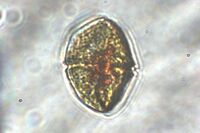Kryptoperidinium foliaceum
Classification
Eukaryota; Sar; Alveolata; Dinophyceae; Peridiniales; Kryptoperidiniaceae; Kryptoperidinium
[Others may be used. Use NCBI link to find]
Species
|
NCBI: Taxonomy |
Kryptoperidinium foliaceum
Description and Significance
The external appearnace of this microbe is with it having a round, imperfect circular shape. In color, it appears to be a golden brownish color. On the surface, there are many smaller circles, and important to note, there is an eyespot almost exactly in the center. The habitat of this species is typically marine environments, more specifically, areas with a hypersaline environment as Kryptoperidinium foliaceum thrive under saline conditions, although sometimes it can be found in costal areas and estuaries as well. In fact, Kryptoperidinium foliaceum was first discovered in a hypersaline environment in Kuwait. There was a direct correlation between the saline concentration and the Kryptoperidinium foliaceum population, the higher the saline concentration, the higher the population.
Genome Structure
Describe the size and content of the genome. How many chromosomes? Circular or linear? Other interesting features? What is known about its sequence?
Cell Structure, Metabolism and Life Cycle
Interesting features of cell structure; how it gains energy; what important molecules it produces.
Ecology and Pathogenesis
Kryptoperidinium foliaceum can be found in various regions around the world, including the Mediterranean Sea, the Gulf of Mexico, and the Atlantic and Pacific coasts of North America. It is a common inhabitant of coastal waters, such as shallow water lagoons, estuaries and tidal creeks. K. foliaceum tends to thrive in environments with high salinity levels, but can tolerate a great range of salinities, from fresh and brackish waters up to waters with hypersalinity. The density of the Kryptoperidinium foliaceum population and distribution in many areas has been strongly correlated with a salinity pattern, as higher salinities tend to have a higher population of K. foliaceum.
High salinities have also been correlated with Kryptoperidinium foliaceum blooms. These algal blooms are harmful to the fish, invertebrates, and other marine organisms in the regions where they occur. While many dinoflagellate blooms produce toxins, K. foliaceum blooms do not, and instead cause noxious odors and kill fish and other organisms by depleting the water of its dissolved oxygen.
References
Author
Page authored by Harini Sunder and Hunter Trier, students of Prof. Jay Lennon at Indiana University.

